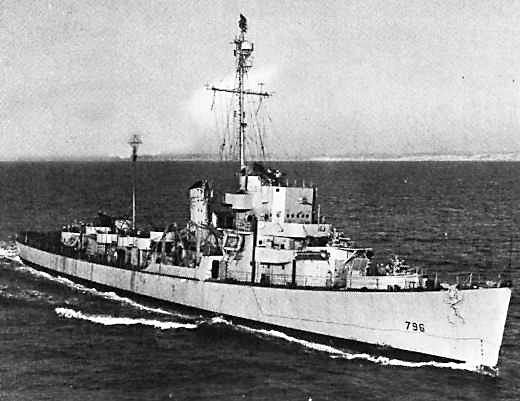Name USS Major Construction started 16 August 1943 Length 93 m Displacement 1.27 million kg | Laid down 16 August 1943 Launched 23 October 1943 Weight 1,422 tons | |
 | ||
Namesake Charles Nance Major, who died when the ship on which he was serving as armed guard, the SS R. P. Resor, was torpedoed off Manasquan, New Jersey, by U-578 late 26 February 1942. Sponsored by Ens. Margaret Roper Major, Ensign Major’s widow Commissioned 12 February 1944 at Orange, Texas Decommissioned 13 March 1948 at Long Beach, California Builder Consolidated Steel Corporation | ||
USS Major (DE-796) was a Buckley-class destroyer escort acquired by the U.S. Navy during the latter part of World War II. She served as an escort vessel, protecting Allied ships, both in the Atlantic Ocean, and later in the Pacific Ocean. When the war with Japan ended, Major witnessed the Japanese surrender from her berth in Tokyo Bay.
Contents
Constructed in Texas
Major (DE 796) was laid down by Consolidated Steel Corp., Orange, Texas, 16 August 1943; launched 23 October 1943; sponsored by Ens. Margaret Roper Major, Ensign Major’s widow; and commissioned at Orange, Texas, 12 February 1944, Lt. Comdr. O. W. Goepner in command.
North Atlantic convoy escort duty
Following shakedown off Bermuda, Major served in the Caribbean Sea frontier and escorted convoys between Cuba and Trinidad until arriving Boston, Massachusetts, 11 June. She underwent training out of Casco Bay, Maine, with ships of Escort Division 56 before arriving Yorktown, Virginia, 2 July for convoy escort duty. On 4 July she sailed as part of Task Force 61 and escorted UGS-47, a 68 ship convoy, to Bizerte, Tunisia, where she arrived 23 July. Between 30 July and 18 August she escorted a westbound convoy back to the United States.
Major again sailed with Task Force 61 as convoy escort 12 September, but on the 25th she left UGS-54 and steamed to Plymouth, England, arriving 29 September. There she met a convoy of 18 LSTs and 20 LCIs, and between 5 and 24 October she sailed as escort to Charleston, South Carolina. During the next 2 months Major made another convoy run to North Africa and back; and, after returning to Boston 29 December, she served as submarine training target ship out of New London, Connecticut. Thence she sailed 21 February 1945 for duty in the Pacific.
Pacific Ocean operations
Arriving Manus, Admiralties, 1 April, Major escorted a convoy from Hollandia, New Guinea, to Leyte Gulf, Philippines, where she reported for duty with the Philippine Sea frontier. During the remainder of the war she operated out of Leyte Gulf, patrolling for enemy submarines, providing passenger and mail service to islands in the southern Philippines, and conducting periodic convoy escort duty, including a run to New Guinea and back. Late in July she reached Okinawa as escort for an LST convoy, thence she departed 1 August guarding LSTs bound for Leyte. Three days later, as Earl V. Johnson (DE-702) dueled with a Japanese submarine, Major protected the convoy, which arrived at Leyte Gulf 7 August.
Witnessing the surrender in Tokyo Bay
Following the cessation of hostilities 15 August, Major steamed to Manila 18 August and escorted LSTs to Japan. She anchored near mighty Missouri (BB-63) in Tokyo Bay 1 September and the following day witnessed the Japanese surrender on board the giant battleship. After returning to the Philippines later that month, she operated out of Leyte.
Post-war decommissioning
Late in 1945 she steamed to the U.S. West Coast. Major decommissioned at Long Beach, California, 13 March 1948 and entered the Pacific Reserve Fleet berthed with the Pacific Inactive Fleet at Stockton, California. Major was sold for scrapping 27 November 1973.
